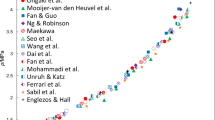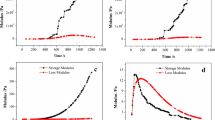Abstract
The knowledge of the thermodynamic parameters related to the hydration of organic solid phases is paramount to exert a very good control over this transition during industrial production or storage. To study this phenomenon, the citric acid was chosen as a model compound. By an original combination of gravimetric and thermal analyses (dynamic vapor sorption and discontinuous isoperibolic thermal analysis, respectively) with structural determination (prototype of in situ X-ray diffractometer) the hydrate/anhydrate transition of the citric acid was thermodynamically characterized by determining: (i) the temperature associated to the peritectic transition <CA, 1H2O> ↔ <CA> + H2Ol, as well as (ii) the minimum relative humidity of hydration, and (iii) the critical relative humidity of deliquescence versus temperature. All these studies lead to the proposition of phase diagram between citric acid and water as a function of temperature and partial vapor pressure of water.












Similar content being viewed by others
References
Chew JW, Chow PS, Tan RBH. Automated in-line technique using FBRM to achieve consistent product quality in cooling crystallization. Cryst Growth Des. 2007;7:1516–22.
Meenan PA, Anderson SR, Klug DL. The influence of impurities and solvents on crystallization. In: Myerson AS, editor. Handbook of industrial crystallization. 2nd ed. Boston: Butterworth-Heinemann; 2002, pp. 67–97.
Coquerel G. The ‘structural purity’ of molecular solid—an elusive concept? Chem Eng Process. 2006;45:857–62.
Morris KR. Structural aspects of hydrates and solvates. In: Brittain HG, editor. Polymorphism in pharmaceutical solids. New York: Marcel Dekker; 1999. p. 125–81.
Boai M, Xiaopeng S, Songgu W, Junbo G. A study on the way of the water escaping from citric acid hydrate. In BIWIC 2012 Proceeding, Tianjin.
Wyrzykowski D, Hebanowska E, Nowak-Wiczk G, Makowski M, Chmurzynski L. Thermal behaviour of citric acid and isomeric aconitic acids. J Therm Anal Calorim. 2011;104:731–5.
Laguerie C, Aubry M, Couderc JP. Some physicochemical data on monohydrate citric acid solutions in water: solubility, density, viscosity, diffusivity, ph of standard solution, and refractive index. J Chem Eng Data. 1976;21:85–7.
Perry JH. Chemical engineers handbook. 4th ed. New York: McGraw-Hil; 1962.
Kirk FE, Othmer DF. Encyclopedia of chemical technology, vol. 5. New York: Wiley; 1964.
Groen H, Robert K. Nucleation, growth, and pseudo-polymorphic behavior of citric acid as monitored in situ by attenuated total reflection fourier transform infrared spectroscopy. J Phys Chem B. 2001;105:10723–30.
Dalman LH. The solubility of citric and tartaric acids in water. J Am Chem Soc. 1937;59:2547–9.
European Citric Acid Manufacturers Association, General information on citric acid monohydrate 1998. http://www.ecama.org/level_2/framesold2/safety_fr.htmln. Accessed 25 Oct 2012.
Coquerel G, Sanselme M, Lafontaine A. Method and measuring scattering of X-rays, its applications and implementation device. 2012, WO2012/136921 A1.
Glusker JP, Minkin JA, Patterson AL. X-ray crystal analysis of substrates of aconitase. IX. A refinement of anhydrous citric acid. Acta Cryst Sect B. 1969;25:1066–72.
Roelofsen G, Kanters JA. Citric acid monohydrate, C6H8O7, H2O. Cryst Struct Commun. 1972;1:23–35.
Marchand P, Lefebvre L, Courvoisier L, Counioux JJ, Coquerel G. Discontinuous isoperibolic thermal analysis (DITA) applied to organic components. J Phys IV. 2001;11:115–22.
Authelin JR. Thermodynamics of non-stoichiometric pharmaceutical hydrates. Int J Pharm. 2005;303:37–53.
Komunjer L, Pezron I. A new experimental method for determination of solubility and hyper-solubility of hygroscopic solid. Powder Technol. 2009;190:75–8.
Févotte G, Caillet A, Sheibat ON. A population balance model of the solution-mediated phase transition of citric acid. AIChE J. 2007;53:2578–89.
Author information
Authors and Affiliations
Corresponding author
Rights and permissions
About this article
Cite this article
Lafontaine, A., Sanselme, M., Cartigny, Y. et al. Characterization of the transition between the monohydrate and the anhydrous citric acid. J Therm Anal Calorim 112, 307–315 (2013). https://doi.org/10.1007/s10973-012-2798-0
Published:
Issue Date:
DOI: https://doi.org/10.1007/s10973-012-2798-0




